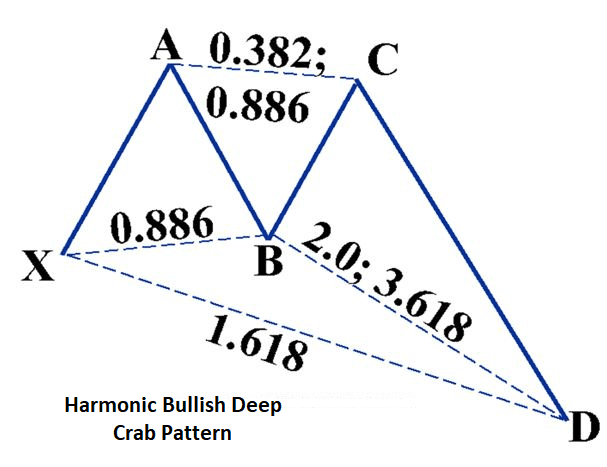Forex trading strategies for using the Harmonic Bullish Deep Crab pattern: Approaches for trading with the Harmonic Bullish Deep Crab pattern.
In the ever-evolving realm of forex trading, where every move counts and every pattern matters, traders are constantly seeking ways to enhance their strategies and gain an edge in the market. One such potent tool in a trader's arsenal is the Harmonic Bullish Deep Crab pattern. This article delves into the intricacies of this pattern and explores effective approaches for trading with it.
Table Content
I. Understanding the Harmonic Bullish Deep Crab Pattern
II. Approaches for Trading with the Harmonic Bullish Deep Crab Pattern
1. Identifying the Pattern
2. Confirming Confluence
3. Wait for Price Action Confirmation
4. Set Precise Entry and Exit Points
5. Apply Sound Risk Management
6. Practice Patience and Discipline
7. Back testing and Demo Trading
8. Continual Learning
III. The Bottom Line
Understanding the Harmonic Bullish Deep Crab Pattern
The Harmonic Bullish Deep Crab pattern is a unique configuration that falls within the realm of harmonic trading. Harmonic patterns are distinct price formations that rely on Fibonacci retracement and extension levels to identify potential reversal points in the market. The Bullish Deep Crab pattern is an advanced variation of the classic Crab pattern, and it offers traders a refined way to spot potential bullish reversals with a higher degree of accuracy.

The pattern is characterized by several key Fibonacci levels, including the XA, AB, BC, and CD legs. The defining features of the Bullish Deep Crab pattern include an extended AB leg, where the BC retracement typically exceeds the XA leg's starting point, and a deep CD leg extension beyond the XA leg's endpoint. This unique alignment of Fibonacci levels creates a confluence zone, suggesting a potential reversal in the price trend.
Approaches for Trading with the Harmonic Bullish Deep Crab Pattern
Trading with the Harmonic Bullish Deep Crab pattern requires a strategic approach that combines technical analysis, risk management, and a keen understanding of market dynamics. Here are some effective strategies for incorporating this pattern into your trading repertoire:
1. Identifying the Pattern:
The first step in trading the Harmonic Bullish Deep Crab pattern is accurate identification. Utilizing a reliable charting platform that offers harmonic pattern recognition can greatly streamline this process. Once identified, the pattern's key levels (XA, AB, BC, and CD) should be measured precisely to confirm its validity.
2. Confirming Confluence:
Successful trading is often a result of confluence, where multiple factors align to strengthen the trade setup. In the case of the Harmonic Bullish Deep Crab pattern, seek additional confluence with other technical indicators, such as trendlines, moving averages, or support/resistance zones. When these elements corroborate the pattern's potential reversal, the trade's viability increases.
3. Wait for Price Action Confirmation:
While the pattern itself holds predictive power, waiting for price action confirmation is crucial. Look for bullish reversal candlestick patterns, such as bullish engulfing, hammer, or morning star, near the pattern's completion point. This added layer of confirmation increases the probability of a successful trade.
4. Set Precise Entry and Exit Points:
Precision in setting entry and exit points is essential. Enter the trade near the completion of the CD leg, ensuring that the price shows signs of reversing. Place a stop-loss order below the pattern's low to protect against adverse price movements. As for exit points, consider using a combination of trailing stops, Fibonacci extensions, or areas of significant resistance.
5. Apply Sound Risk Management:
Risk management is the backbone of successful trading. Never risk more than a predetermined percentage of your trading capital on a single trade. A common approach is to risk no more than 1-2% of your capital on any given trade, ensuring that a series of losses doesn't deplete your account.
6. Practice Patience and Discipline:
Trading the Harmonic Bullish Deep Crab pattern requires patience and discipline. Not every potential pattern will result in a successful trade, and impulsive decisions can lead to losses. Stick to your trading plan, and don't let emotions dictate your actions.
7. Back testing and Demo Trading:
Before implementing any strategy in a live trading environment, it's prudent to back test the strategy on historical data and practice it in a demo account. This helps you become familiar with the pattern's behavior, refine your approach, and gain confidence in your trading
decisions.
8. Continual Learning:
The world of forex trading is dynamic, with new insights and strategies emerging regularly. Stay committed to learning and improving your skills. Attend webinars, read trading literature, and engage with other traders to broaden your perspective.
The Bottom Line
Mastering the Harmonic Bullish Deep Crab pattern requires dedication, analysis, and discipline. By incorporating this advanced harmonic pattern into your trading strategies, you can potentially improve your ability to identify high-probability bullish reversals. Remember that no strategy guarantees success, and losses are an inherent part of trading. However, with careful analysis, risk management, and the right mindset, you can enhance your chances of success in the forex market.











Discussion